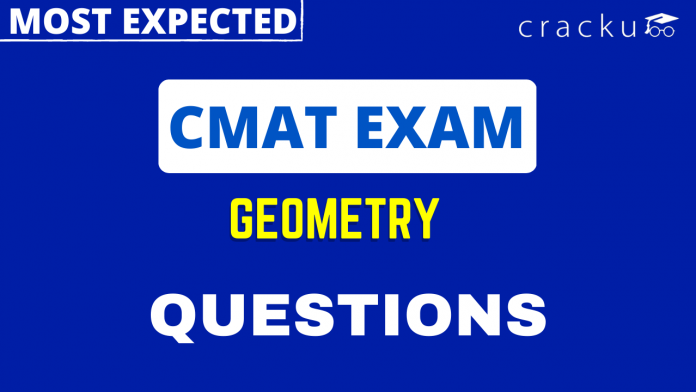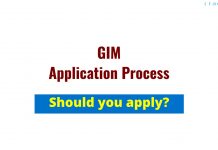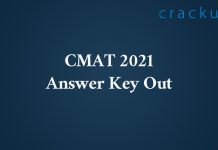CMAT Geometry Questions [Download PDF]
Download Geometry Questions for CMAT PDF – CMAT Geometry questions PDF by Cracku. Practice CMAT solved Geometry Questions paper tests, and these are the practice question to have a firm grasp on the Geometry topic in the XAT exam. Top 20 very Important Geometry Questions for XAT based on asked questions in previous exam papers. Click on the link below to download the Geometry Questions for CMAT PDF with detailed solutions.
Download Geometry Questions for CMAT
Enroll to CMAT 2023 Crash Course
Question 1: In a triangle ABC, AB = AC = 8 cm. A circle drawn with BC as diameter passes through A. Another circle drawn with center at A passes through Band C. Then the area, in sq. cm, of the overlapping region between the two circles is
a) $16\pi$
b) $16(\pi – 1)$
c) $32(\pi – 1)$
d) $32\pi$
1) Answer (C)
Solution:

BC is the diameter of circle C2 so we can say that $\angle BAC=90^{\circ\ }$ as angle in the semi circle is $90^{\circ\ }$
Therefore overlapping area = $\frac{1}{2}$(Area of circle C2) + Area of the minor sector made be BC in C1
AB= AC = 8 cm and as $\angle BAC=90^{\circ\ }$, so we can conclude that BC= $8\sqrt{2}$ cm
Radius of C2 = Half of length of BC = $4\sqrt{2}$ cm
Area of C2 = $\pi\left(4\sqrt{2}\right)^2=32\pi$ $cm^2$
A is the centre of C1 and C1 passes through B, so AB is the radius of C1 and is equal to 8 cm
Area of the minor sector made be BC in C1 = $\frac{1}{4}$(Area of circle C1) – Area of triangle ABC = $\frac{1}{4}\pi\left(8\right)^2-\left(\frac{1}{2}\times8\times8\right)=16\pi-32$ $cm^2$
Therefore,
Overlapping area between the two circles= $\frac{1}{2}$(Area of circle C2) + Area of the minor sector made be BC in C1
= $\frac{1}{2}\left(32\pi\right)\ +\left(16\pi-32\right)=32\left(\pi-1\right)$ $cm^2$
Question 2: The lengths of all four sides of a quadrilateral are integer valued. If three of its sides are of length 1 cm, 2 cm and 4 cm, then the total number of possible lengths of the fourth side is
a) 3
b) 4
c) 6
d) 5
2) Answer (D)
Solution:
Sum of the three sides of a quadrilateral is greater than the fourth side.
Therefore, let the fourth side be
1+2+4>d or d<7
1+2+d>4 or d>1
Possible values of d are 2, 3, 4, 5 and 6.
Question 3: Suppose the medians BD and CE of a triangle ABC intersect at a point O. If area of triangle ABC is 108 sq. cm., then, the area of the triangle EOD, in sq. cm., is
3) Answer: 9
Solution:

Area of ABD : Area of BDC = 1:1
Therefore, area of ABD = 54
Area of ADE : Area of EDB = 1:1
Therefore, area of ADE = 27
O is the centroid and it divides the medians in the ratio of 2:1
Area of BEO : Area of EOD = 2:1
Area of EOD = 9
Question 4: The length of each side of an equilateral triangle ABC is 3 cm. Let D be a point on BC such that the area of triangle ADC is half the area of triangle ABD. Then the length of AD, in cm, is
a) $\sqrt{8}$
b) $\sqrt{6}$
c) $\sqrt{7}$
d) $\sqrt{5}$
4) Answer (C)
Solution:

Area of triangle ABD is twice the area of triangle ACD
$\angle\ ADB=\theta\ $
$\frac{1}{2}\left(AD\right)\left(BD\right)\sin\theta\ =2\left(\frac{1}{2}\left(AD\left(CD\right)\sin\left(180-\theta\ \right)\right)\right)$
$BD\ =2CD$
Therefore, BD = 2 and CD = 1
$\angle\ ABC=\angle\ ACB=60^{\circ\ }$
Applying cosine rule in triangle ADC, we get
$\cos\angle\ ACD=\ \frac{\ AC^2+CD^2-AD^2}{2\left(AC\right)\left(CD\right)}$
$\frac{1}{2}=\ \frac{\ 9+1-AD^2}{6}$
$AD^2=7$
$AD=\sqrt{\ 7}$
The answer is option C.
Question 5: Regular polygons A and B have number of sides in the ratio 1 : 2 and interior angles in the ratio 3 : 4. Then the number of sides of B equals
5) Answer: 10
Solution:
Let the number of sides of polygons A and B be n and 2n, respectively.
$\ \dfrac{\ \ \dfrac{\ \left(n-2\right)180}{n}}{\ \dfrac{\ \left(2n-2\right)180}{2n}}=\dfrac{3}{4}$
$\ \dfrac{\ \ \ n-2}{\ \ n-1}=\dfrac{3}{4}$
$\ \ \ \ 4n-8=3n-3$
$n=5$
The number of sides of polygon B is 2*5, i.e. 10.
Question 6: In triangle ABC, altitudes AD and BE are drawn to the corresponding bases. If $\angle BAC = 45^{\circ}$ and $\angle ABC=\theta\ $, then $\frac{AD}{BE}$ equals
a) $\sqrt{2} \cos \theta$
b) $\frac{(\sin \theta + \cos \theta)}{\sqrt{2}}$
c) 1
d) $\sqrt{2} \sin \theta$
6) Answer (D)
Solution:

It is given, Angle BAE = 45 degrees
This implies AE = BE
Let AE = BE = x
In right-angled triangle ABD, it is given $\angle ABC=\theta\ $
$\sin\theta=\frac{AD}{AB}\ $
$\sin\theta=\frac{AD}{x\sqrt{\ 2}}\ $
$\sqrt{\ 2}\sin\theta=\frac{AD}{BE}\ $
The answer is option D.
Question 7: Let ABCD be a parallelogram such that the coordinates of its three vertices A, B, C are (1, 1), (3, 4) and (−2, 8), respectively. Then, the coordinates of the vertex D are
a) (0, 11)
b) (4, 5)
c) (−3, 4)
d) (−4, 5)
7) Answer (D)
Solution:
In a parallelogram, two diagonals of parallelogram bisects each other, which concludes that mid-point of both diagonals are the same.
Midpoint of AC = $\left(\ \frac{\ 1-2}{2},\ \frac{\ 1+8}{2}\right)$
Let the coordinates of vertex D be (x,y)
$\left(\ \frac{\ x+3}{2},\ \frac{\ y+4}{2}\right)=\left(\ \frac{\ 1-2}{2},\ \frac{\ 1+8}{2}\right)$
x = -4 and y = 5
The answer is option D.
Question 8: All the vertices of a rectangle lie on a circle of radius R. If the perimeter of the rectangle is P, then the area of the rectangle is
a) $\frac{P^2}{16} – R^2$
b) $\frac{P^2}{8} – 2R^2$
c) $\frac{P^2}{2} – 2PR$
d) $\frac{P^2}{8} – \frac{R^2}{2}$
8) Answer (B)
Solution:

$A=lb$
$l^2+b^2=4r^2$
$P\ =2\left(l+b\right)$
$\frac{P}{2}=l+b$
Squaring on both the sides, we get
$\frac{P^2}{4}=l^2+b^2+2lb$
$\frac{P^2}{4}=4r^2+2lb$
$\frac{P^2}{8}-2r^2=lb$
The answer is option B.
Question 9: A trapezium $ABCD$ has side $AD$ parallel to $BC, \angle BAD = 90^\circ, BC = 3$ cm and $AD= 8$ cm. If the perimeter of this trapezium is 36 cm, then its area, in sq. cm, is
9) Answer: 66
Solution:

CD = $\sqrt{\ y^2+25}$
$11+y+\sqrt{y^2+25}=36$
$\sqrt{y^2+25}=25-y$
$y^2+25=25^2+y^2-50y$
2y = 24
y = 12
Area of trapezium = $3y+\frac{5y}{2}=\frac{11y}{2}=\frac{11}{2}\left(12\right)=66$
Question 10: If a 30 meter ladder is placed against a wall such that it just reaches the top of the wall, if the horizontal distance between the wall and the base of the ladder is 1/3rd of the length of ladder, then the height of wall is :
a) 25 meter
b) $20\sqrt{2}$ meter
c) $20\sqrt{3}$ meter
d) 20 meter
10) Answer (B)
Solution:

AC is ladder, C is base of ladder, AB is wall
Given AC = 30 m and BC = $\frac{1}{3}AC$ = $\frac{1}{3}\left(30\right)$ = 10 m
Applying pythagoras theorem,
$AB^2+\ BC^2=\ AC^2$
$AB^2$ = $30^2-10^2$ = 800
AB = $20\sqrt{\ 2}$
Answer is option B.
Question 11: A copper wire having length of 243m and diameter 4 mm was melted to form a sphere. Find the diameter of the sphere :
a) 17 m
b) 18 cm
c) 15 cm
d) 20 cm
11) Answer (B)
Solution:
Volume of copper wire melted will be equal to volume of sphere.
Volume of copper wire = Area $\times\ $ length = $\pi\ \left(\frac{2}{10}\right)^2\times\ 24300\ cm^3$
Let the radius of sphere be r
$\frac{4}{3}\pi\ r^{3\ \ }=\ \pi\ \left(\frac{2}{10}\right)^2\times\ 24300\ cm^3$
$r^3$ = 729
r = 9 cm
Diameter of sphere = 2(9) = 18 cm
Answer is option B.
Question 12: If a cuboidal box has height, length and width as 20 cm, 15 cm and 10 cm respectively. Then its total surface area is__________.
a) 1300$cm^{2}$
b) 1400$cm^{2}$
c) 1200$cm^{2}$
d) 1100$cm^{2}$
12) Answer (A)
Solution:
Total surface area = 2(lb + bh + hl) = 2(150 + 200 + 300) = 1300 $cm^2$
Answer is option A.
Question 13: Angle bisectors of a parallelogram form a _____.
a) parallelogram
b) square
c) rhombus
d) rectangle
13) Answer (D)
Solution:

Angular bisectors from A and B intersect at P, B and D intersect at Q, C and D intersect at R, and A and C intersect at S.
In a parallelogram ABCD, AC is parallel to BD.
$\angle\ CAB\ +\angle\ ACD\ =\ 180^{\circ\ }$
$\angle\ CAS\ +\angle\ ACS\ =\ 90^{\circ\ }$
In triangle CAS,
$\angle\ ASC\ =\ 180^{\circ\ }-90^{\circ\ }=90^{\circ\ }$
As all the angles of PQRS are $90^{\circ\ }$, PQRS is a rectangle.
Answer is option D.
Question 14: A tree bends due to heavy storm and now its peak touches the ground making an angle of $30^{\circ}$ with it. If the bent part is 20 metre long, find the original height of the tree in metres.
a) 10
b) 20/√3
c) 40
d) 30
14) Answer (D)
Solution:

BC is ground and it is given that $\angle\ ACB\ =30^{\circ\ }$
Actual length of the tree = AB + AC
$\sin30^{\circ\ }=\frac{AB}{AC}$
AB = 20/2 = 10 cm
Length of the tree = AB + AC = 10 + 20 = 30 cm
Answer is option D.
Question 15: $ABC$ is a triangle, $\angle B=60^\circ, \angle C=45^\circ$, BC is produced to / extended till D so that $\angle ADB=30^\circ$, then given $\sqrt{3}=\frac{19}{11}$ and $BC \times CD=3^{4}\times 2^{3}\times\frac{11}{19}$, what will be the square of the altitude from A to BC?
a) 144
b) 324
c) 484
d) 1254
15) Answer (B)
Solution:

AE is altitude from A on BC. $\angle\ AEC\ =\ 90^{\circ\ }$
It is given,
$\angle\ ABC\ =\ 60^{\circ\ },\ \angle\ ACB\ =\ 45^{\circ\ }$
In triangle ABE,
AE = $\sqrt{\ 3}x$
As $\angle\ EAC\ =\angle\ ECA$, EC = $\sqrt{\ 3}x$
In triangle AED, $\angle\ EAD\ =\ 60^{\circ\ }$
Therefore, CD = $3x-\sqrt{\ 3}x$
It is given,
$BC\ \cdot\ CD\ =\ \frac{3^4.2^3.11}{19}$
$x\left(\sqrt{\ 3}+1\right)\sqrt{\ 3}\left(\sqrt{\ 3}-1\right)x\ =\ \frac{3^4.2^3.11}{19}$
$x\ =\ \frac{3^2.2.11}{19}$
AE = 9*2 = 18
$AE^2$ = 324
Answer is option B.
Question 16: ABCD is a rectangle in the clockwise direction. The coordinates of A are (1,3) and the coordinates of C are (5,1), the coordinates of vertices B and D satisfy the line $y=2x+c$, then what will be the coordinates of the mid-point of BC.
a) $(\frac{5}{2},\frac{7}{2})$
b) $(\frac{9}{2},\frac{5}{2})$
c) $(\frac{9}{5},\frac{7}{2})$
d) $(3,2)$
16) Answer (B)
Solution:

Midpoint of AC passes through the line y = 2x + c
Midpoint of AC = (3,2)
2 = 6 + c
c = -4
Line passing through B is y = 2x – 4
(slope of AB)(slope of BC) = -1
$\left(\ \frac{\ y-1}{x-5}\right)\left(\ \frac{\ y-3}{x-1}\right)=-1$
Substituting y = 2x – 4 and solving, we get
B(2,0) or B(4,4)
B cannot lie on X-axis. Therefore, co-ordinates of B = (4,4)
Midpoint of BC = $\left(\frac{9}{2},\frac{5}{2}\right)$
The answer is option B.
Question 17: In a figure, $\triangle ABC$ is a right angled triangle at $C$, semicircles are drawn on $AC$, $BC$ and $AB$’s diameter. Find the area of the shaded region.

Note: Figure not as per scale
a) 336
b) 676
c) 196
d) 556
17) Answer (A)
Solution:
Area of shaded region = area of semicircle on BC + area of semicircle of AC – area of unshaded semicircle regions
Area of unshaded semicircle regions = area of semicircle on AB – area of triangle ABC
Given,
AB = 50, BC = 14
In triangle ABC, $AC^2+BC^2 = AB^2$
Solving we get,
AC = 48
Area of unshaded semicircle regions = $\ \frac{\pi\ \left(25\right)^2}{2}\ -\frac{1}{2}\times\ 48\times\ 14=\frac{625\pi\ }{2}-336$
Area of shaded region = $\frac{576\pi\ }{2}\ +\frac{49\pi}{2}\ -\frac{625\pi}{2}\ +336$ = 336
The answer is option A.
Question 18: In the figure (not drawn to scale) given below, if $AD=CD=BC$ and angle $BCE = 81^\circ$, how much is the value of angle $DBC$?

a) $27^\circ$
b) $33^\circ$
c) $54^\circ$
d) $66^\circ$
18) Answer (C)
Solution:
Given,
AD = DC, this implies angle ACD = angle DAC = x
DC = BC, this implies angle CDB = angle CBD = 2x
$\angle\ DCB$ = 180 – x – 81 = 99 – x
In triangle BCD, sum of the angles is 180 degrees
99 – x + 2x + 2x = 180
3x = 81
x = 27
$\angle\ DBC$ = 2x = 54 degrees
The answer is option C.
Question 19: A triangular park named ABC, is required to be protected by green fencing. The length of the side BC is 293. If the length of side AB is a perfect square, the length of the side AC is a power of two (2), and the length of side AC is twice the length of side AB. Determine how much fencing is required to cover the triangular park.
a) 1079
b) 1024
c) 1096
d) 1061
19) Answer (D)
Solution:
ABC is a triangle and BC = 293
Let the length of AB = $x^2$
The length of AC = $2^y$
AC = 2AB
$2^y = 2.x^2$
$2^{y-1} = x^2$
$2^{y-1}$ is a perfect square when y is odd.
Sum of any two sides of a triangle should be larger than the third side. Therefore,
$2^y + x^2$ > 293, 293 + $2^y$ > $x^2$ and 293 + $x^2$ > $2^y$
y > 8
If y = 9, AC = 512, x = 16; satisfies above equations.
If y = 11, AC = 2048, x = 32; doesn’t satisfy above equations.
Therefore, AB = 256 and AC = 512
Fencing required = 256 + 512 + 293 = 1061
Answer is option D.
Question 20: The angle of elevation of a glider from the deck of ship 25 meters above the sea surface is $30^\circ$ nd the angle of depression of the reflection of glider in the sea is $75^\circ$. Find the approximate height of the glider from the sea surface. $\sqrt{3}=\frac{19}{11}$
a) 46
b) 34
c) 29
d) 52
20) Answer (B)
Solution:

It is given, angle ABC = 30 degrees and angle FBC = 75 degrees
$\tan\ 30^{\circ\ }=\frac{x}{BC}$
$BC\ =\ x\sqrt{\ 3}$
$\tan75^{\circ\ }=\ \frac{\ 50+x}{x\sqrt{\ 3}}$
$2+\sqrt{\ 3}\ =\ \frac{\ 50+x}{x\sqrt{\ 3}}$
Solving we get x = 9.1
Height of glinder from sea surface = 25+x $\approx\ $ 34
Answer is option B.





